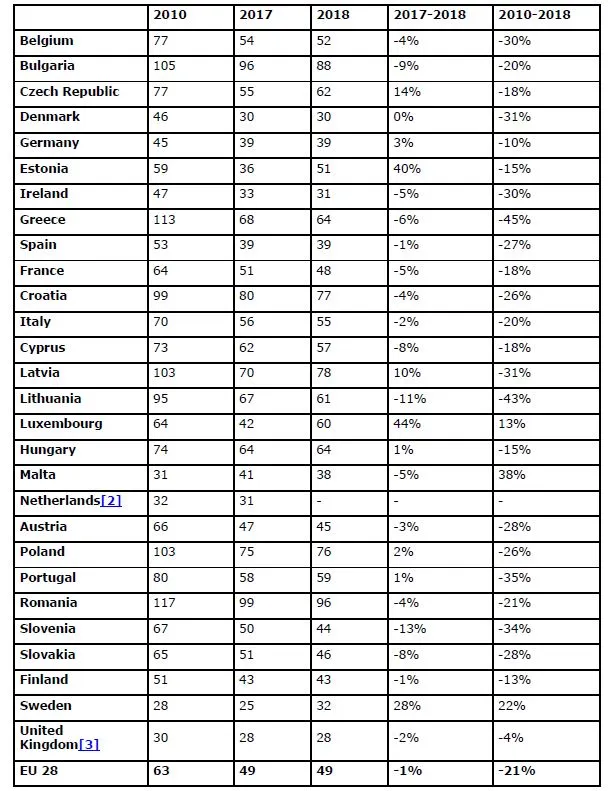The European Union is making serious moves to tackle road fatalities in a bid to cut Europe's road death rates to 25,000/year by 2010. So far, measures taken have had little effect, bringing the number down by just 18% to 41,000/year.
April 16, 2012
Read time: 3 mins
The 1116 European Union is making serious moves to tackle road fatalities in a bid to cut Europe's road death rates to 25,000/year by 2010. So far, measures taken have had little effect, bringing the number down by just 18% to 41,000/year.
Some of the measures have greater potential than others. It is debatable whether making drivers use headlights in daytime will be of any benefit. There is also debate over whether tackling speeding will offer anything but limited reductions in accidents.
Safety gains could come from road upgrades. A damning report by the European Road Assessment Programme (1200 EuroRAP) says that many lives could be saved on Europe's roads if member states would meet basic safety requirements. Drink driving has also long been linked to vehicle crashes and has now been recognised as a priority for EU member states.
The EuroRAP report says that many road deaths are caused by poor road layout and that inexpensive modifications could cut the fatality rate. Fatalities could be cut with simple improvements, such as better road markings or installing safety barriers.
This carnage is hitting Europe's economy hard. The reports says that accidents on European roads have caused 500,000 deaths over the last 10 years, costing an estimated €160 billion/year and equivalent to 2% of the EU's GDP.
EuroRAP chairman John Dawson said: "Making roads safer provides some of the highest returns in terms of lives and money saved anywhere in the European economy." With regard to drink driving, the statistics provide a stark warning. Of the 41,000 fatalities/year on Europe's roads, reports suggest that 13,000-17,000 are caused by drunk drivers. Members of the European Parliament's Transport Committee recently attempted to pass a report recommending the2465 European Commission to propose an EU-wide upper limit of 0.5% blood alcohol levels for all drivers.
Cutting down on drink driving will save lives. Sweden and Finland have particularly tough policies against drink driving.
It is no coincidence that Sweden has amongst the lowest rate of road fatalities in the EC.
However drunk driving is rife in many countries and simply reducing the allowable blood alcohol limits will be useless without enforcement.
While the UK allows drivers higher blood alcohol levels than many other European countries, these rules have long been enforced and drink driving is generally regarded as a crime. In many European countries much stricter guidelines on blood alcohol levels are virtually ignored by the police.
In France, the tragic death of Princess Diana, in 1997 in a road crash was a factor in drink driving being taken seriously as a road safety issue. Following that incident, as well as another fatality in the South of France, president Chirac initiated a personal crusade for tougher measures against drink driving and bad driving in general. The benefits of president Chirac's safety drive can be seen in France's huge reduction in road fatalities.
Whether road authorities will receive the funds to make simple road improvements, or police forces will have the resources to enforce laws on driving under the influence remains to be seen.
Some of the measures have greater potential than others. It is debatable whether making drivers use headlights in daytime will be of any benefit. There is also debate over whether tackling speeding will offer anything but limited reductions in accidents.
Safety gains could come from road upgrades. A damning report by the European Road Assessment Programme (
The EuroRAP report says that many road deaths are caused by poor road layout and that inexpensive modifications could cut the fatality rate. Fatalities could be cut with simple improvements, such as better road markings or installing safety barriers.
This carnage is hitting Europe's economy hard. The reports says that accidents on European roads have caused 500,000 deaths over the last 10 years, costing an estimated €160 billion/year and equivalent to 2% of the EU's GDP.
EuroRAP chairman John Dawson said: "Making roads safer provides some of the highest returns in terms of lives and money saved anywhere in the European economy." With regard to drink driving, the statistics provide a stark warning. Of the 41,000 fatalities/year on Europe's roads, reports suggest that 13,000-17,000 are caused by drunk drivers. Members of the European Parliament's Transport Committee recently attempted to pass a report recommending the
Cutting down on drink driving will save lives. Sweden and Finland have particularly tough policies against drink driving.
It is no coincidence that Sweden has amongst the lowest rate of road fatalities in the EC.
However drunk driving is rife in many countries and simply reducing the allowable blood alcohol limits will be useless without enforcement.
While the UK allows drivers higher blood alcohol levels than many other European countries, these rules have long been enforced and drink driving is generally regarded as a crime. In many European countries much stricter guidelines on blood alcohol levels are virtually ignored by the police.
In France, the tragic death of Princess Diana, in 1997 in a road crash was a factor in drink driving being taken seriously as a road safety issue. Following that incident, as well as another fatality in the South of France, president Chirac initiated a personal crusade for tougher measures against drink driving and bad driving in general. The benefits of president Chirac's safety drive can be seen in France's huge reduction in road fatalities.
Whether road authorities will receive the funds to make simple road improvements, or police forces will have the resources to enforce laws on driving under the influence remains to be seen.







